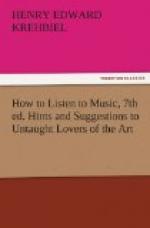[Sidenote: Personal magnetism.]
The layman will perhaps also be enabled, by observing the actions of a conductor with a little understanding of their purposes, to appreciate what critics mean when they speak of the “magnetism” of a leader. He will understand that among other things it means the aptitude or capacity for creating a sympathetic relationship between himself and his men which enables him the better by various devices, some arbitrary, some technical and conventional, to imbue them with his thoughts and feelings relative to a composition, and through them to body them forth to the audience.
[Sidenote: The score.]
[Sidenote: Its arrangement.]
[Sidenote: Score reading.]
What it is that the conductor has to guide him while giving his mute commands to his forces may be seen in the reproduction, in the Appendix, of a page from an orchestral score (Plate XII). A score, it will be observed, is a reproduction of all the parts of a composition as they lie upon the desks of the players. The ordering of these parts in the score has not always been as now, but the plan which has the widest and longest approval is that illustrated in our example. The wood-winds are grouped together on the uppermost six staves, the brass in the middle with the tympani separating the horns and trumpets from the trombones, the strings on the lowermost five staves. The example has been chosen because it shows all the instruments of the band employed at once (it is the famous opening tutti of the triumphal march of Beethoven’s Fifth Symphony), and is easy of comprehension by musical amateurs for the reason that none of the parts requires transposition except it be an octave up in the case of the piccolo, an instrument of four-foot tone, and an octave down in the case of the double-basses, which are of sixteen-foot tone. All the other parts are to be read as printed, proper attention being given to the alto and tenor clefs used in the parts of the trombones and violas. The ability to “read score” is one of the most essential attributes of a conductor, who, if he have the proper training, can bring all the parts together and reproduce them on the pianoforte, transposing those which do not sound as written and reading the different clefs at sight as he goes along.
V
At an Orchestral Concert
[Sidenote: Classical and Popular.]
[Sidenote: Orchestras and military bands.]
In popular phrase all high-class music is “classical,” and all concerts at which such music is played are “classical concerts.” Here the word is conceived as the antithesis of “popular,” which term is used to designate the ordinary music of the street and music-hall. Elsewhere I have discussed the true meaning of the word and shown its relation to “romantic” in the terminology




